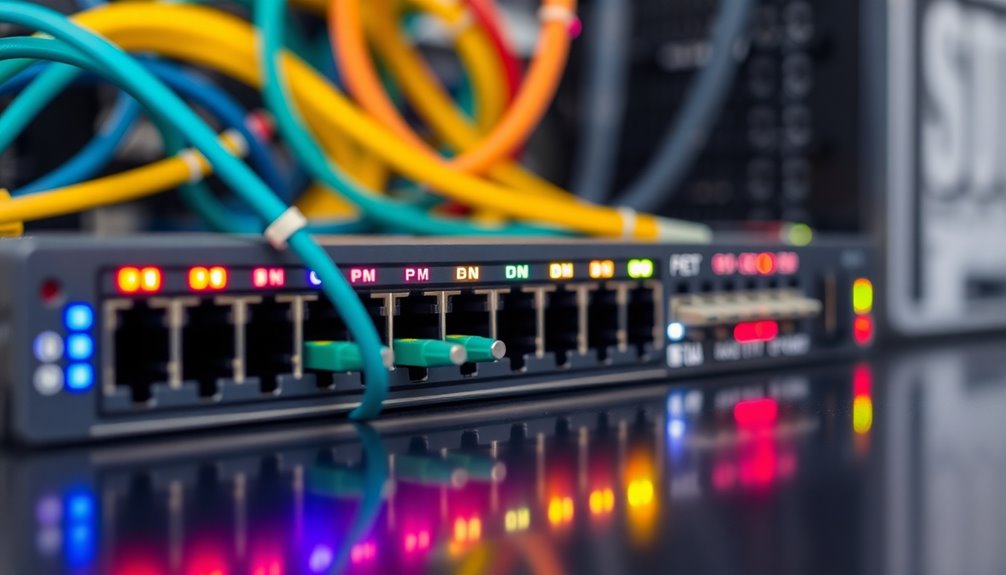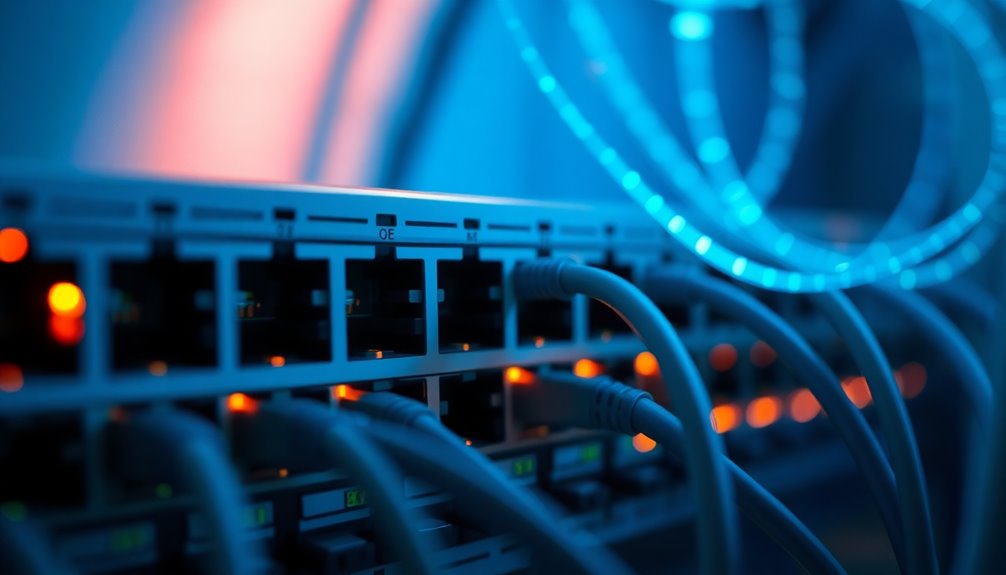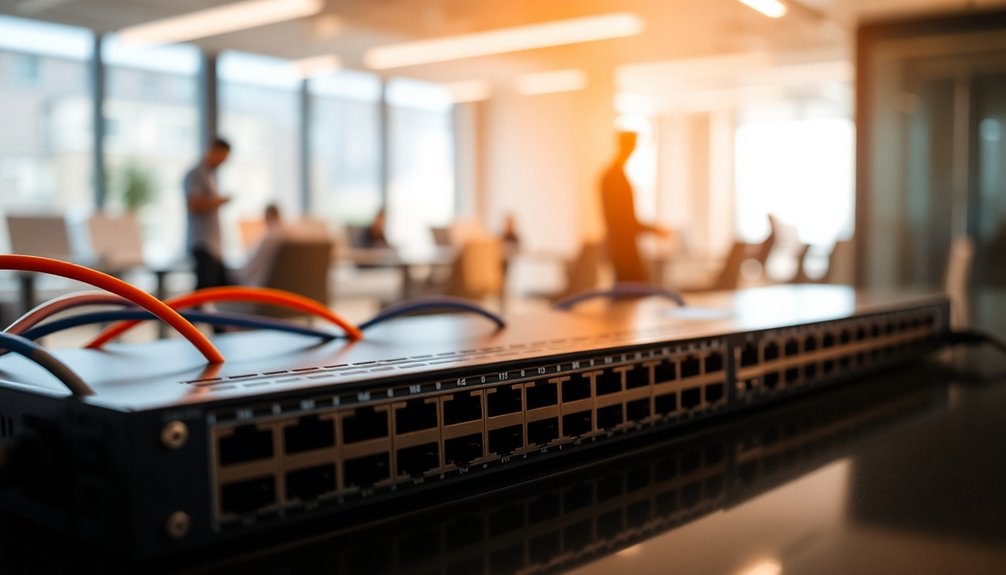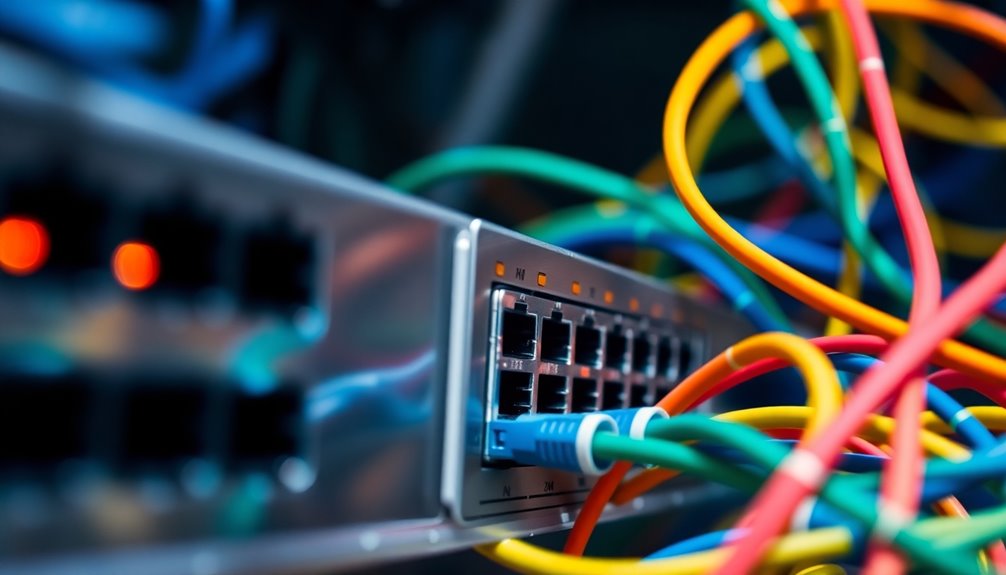Network Layer 2, also known as the Data Link layer, plays a crucial role in how devices communicate within a local area network (LAN). It wraps data into frames using unique MAC addresses to ensure efficient transmission. You'll find protocols like PPP and LAP here, providing reliable data transfer. This layer handles different types of transmission—unicast, multicast, and broadcast—while also employing techniques like VLANs for better performance. Plus, it manages access to the physical medium. If you're curious about how it all ties together and what security concerns you might encounter, there's more to explore!
Key Takeaways
- Layer 2, also known as the Data Link Layer, manages node-to-node data transfer and error detection in a network.
- It comprises two sublayers: LLC (Logical Link Control) and MAC (Media Access Control) for facilitating communication.
- MAC sublayer handles device identification through unique MAC addresses and controls access to the physical medium.
- Layer 2 supports various protocols, including PPP and LAP, ensuring reliable data transmission across networks.
- It enables functionalities like VLANs, unicast, multicast, and broadcast transmissions for efficient data management.
Layer 2 Data Link Protocols

When you're diving into Layer 2 Data Link Protocols, you'll find that they play a crucial role in managing communications between devices on a network.
This layer consists of two main sublayers: Logical Link Control (LLC) and Media Access Control (MAC). LLC, defined in IEEE 802.2, supports both connectionless and connection-oriented services, enabling multiple higher-layer protocols to share a single data link.
On the other hand, MAC handles access to the physical medium, assigns unique MAC addresses, and manages frame transmission and collision detection. Additionally, protocols like Point-to-Point Protocol (PPP) and Link Access Procedure (LAP) facilitate reliable data transmission across point-to-point links, ensuring effective communication between devices in various network environments. Wide Area Networks often rely on these protocols to maintain consistent and reliable connectivity across vast distances.
Overview of Layer 2

Layer 2 serves as the backbone of local area network (LAN) communications, managing the essential data transfer between devices. It encapsulates data packets into frames, ensuring accurate and efficient transfer through error detection, synchronization, and flow control.
Utilizing switching and bridging technologies, it facilitates smooth communication while handling both physical and data link connections. You'll find that Layer 2 uses MAC addresses to identify devices, with source and destination addresses included in frame headers. It distinguishes between unicast, multicast, and broadcast transmissions, enhancing data integrity without needing layer 3 routing protocols. Additionally, it supports the creation of virtual LANs (VLANs) and enables network mapping to improve manageability and performance across your LAN.
Moreover, Layer 2 is responsible for local area network communication, ensuring effective data transmission among adjacent network nodes.
Frame Transmission Process

Understanding how data is framed and transmitted is key to grasping Layer 2 operations. When your device sends data, it encapsulates packets into frames, adding MAC addresses for both the source and destination.
The frame starts with a preamble for synchronization, followed by the Start Frame Delimiter, the destination MAC, source MAC, and a type field that indicates the upper layer protocol. Layer 2 networks manage MAC addresses for device identification and play a crucial role in facilitating this process.
As the frame travels, the Network Interface Card (NIC) checks the destination MAC address to ensure it's meant for your device. If an error occurs, such as in the Frame Check Sequence, the frame gets discarded.
Switches then use their MAC address tables to decide where to forward the frames, maintaining efficient communication across the network.
Benefits and Drawbacks

While the benefits of Network Layer 2 are significant, it's essential to consider its drawbacks as well. One major limitation is its scalability; it's generally more suited for small local area networks and struggles with larger, complex environments. Since it relies heavily on MAC addresses, there's a risk of MAC table overflow, and dynamic networks can complicate address management. Additionally, while it's cost-effective, the complexity of VLAN configuration and management can be daunting. Lastly, despite its security features, vulnerabilities like ARP spoofing and MAC flooding can threaten network integrity. Balancing these advantages and disadvantages is crucial for effective network design and operation. Layer 2 solutions also aim to enhance scalability, but they can introduce new security risks that must be managed carefully.
Ethernet vs. Wi-Fi Performance

When it comes to network performance, the choice between Ethernet and Wi-Fi can significantly impact your experience.
Ethernet connections offer speeds up to 10 Gbps, lower latency around 16 ms, and consistent throughput, making them ideal for activities like streaming HD video and gaming. Additionally, Ethernet provides greater stability due to its direct cable connection, which is crucial for uninterrupted performance.
In contrast, Wi-Fi 6E can theoretically reach speeds up to 9.6 Gbps, but real-world performance often falls short, with average pings around 60 ms.
Wi-Fi is more convenient for portable devices, but it shares bandwidth among all connected devices, leading to potential slowdowns.
For tasks that require high performance and reliability, like transferring large files, Ethernet is the clear winner.
For general browsing, Wi-Fi may suffice, but it's not always dependable.
Security Vulnerabilities in Layer 2

Though Ethernet and Wi-Fi offer different performance levels, they also share vulnerabilities that can compromise network security. You need to be aware of several Layer 2 attack types.
MAC table attacks can flood switches with fake addresses, causing them to broadcast packets to all ports. VLAN attacks, like VLAN hopping, allow attackers to manipulate network segmentation.
ARP attacks link an attacker's MAC address to a legitimate IP, enabling man-in-the-middle scenarios. DHCP spoofing redirects client traffic through false responses.
Additionally, attackers can bypass network filters using vulnerabilities like CVE-2021-27853. To protect your network, implement measures such as Dynamic ARP Inspection, DHCP Snooping, and VLAN Access Control Lists. Exploitation of these vulnerabilities can enable adjacent attackers to bypass security features, affecting first-hop security across multiple Cisco products.
Regularly updating security policies and configurations is crucial for maintaining Layer 2 security.
Emerging Layer 2 Technologies

As blockchain technology continues to evolve, emerging Layer 2 solutions are transforming how transactions are processed, making them faster and more cost-effective. You'll find various types of Layer 2 technologies, like Optimistic Rollups, which assume transactions are valid unless proven otherwise, cutting gas costs by up to 95%. Zero-Knowledge Rollups enhance privacy and efficiency, ideal for DeFi and NFT applications. State Channels allow peer-to-peer transactions off-chain, perfect for micropayments, while Sidechains enable transactions on separate blockchains, supporting smart contracts. Notable networks like Arbitrum, Lightning Network, and Polygon lead the charge, offering impressive throughput and drastically reduced transaction costs. Layer-2 solutions play a crucial role in facilitating the mass adoption of blockchain technology, driving expansion into diverse industries beyond finance. With these innovations, you're witnessing a significant leap in blockchain scalability and usability.
Optimize MAC Address Management

Optimizing MAC address management is crucial for maintaining network efficiency and security. Start by configuring static MAC addresses to specific interfaces using commands like 'mac-address static'. This ensures consistency across your MAC address tables. Implement MAC address filtering with blacklists and whitelists to control device access, enhancing security. Adjust the MAC address aging time to clear unused entries quickly, and regularly audit your MAC address table to maintain accuracy. Additionally, ensure your configuration aligns with address table management best practices to maximize performance.
Consider using MAC-based VLANs for dynamic assignments and port-MAC binding for access control. Automate your management processes with asset tracking software and monitoring tools to detect real-time threats.
Frequently Asked Questions
How Does Layer 2 Differ From Layer 1 in Networking?
Layer 2 differs from Layer 1 in that it builds on the existing network infrastructure to enhance scalability and transaction speeds.
While Layer 1 focuses on core operations, security, and decentralization, Layer 2 offloads some processing tasks, which allows for quicker transactions.
You'll find Layer 2 solutions, like the Lightning Network, improving efficiency without compromising the foundational security provided by Layer 1 networks.
This synergy helps optimize overall network performance.
What Devices Operate Primarily at Layer 2?
Think of Layer 2 as the conductor of an orchestra, coordinating communication between devices.
At this level, you'll find switches, which efficiently route data within a network using MAC addresses. Bridges connect different segments, while network interface cards (NICs) enable devices to join the symphony.
Although hubs once played a role, they've been largely replaced by more efficient technologies. Each device ensures smooth data flow, enhancing overall network performance.
Can Layer 2 Technologies Support Virtual Networks?
Yes, Layer 2 technologies can absolutely support virtual networks.
You can use VLANs to create isolated virtual segments within a physical network. This allows multiple virtual networks to coexist without interference.
By employing Layer 2 VPNs, you can securely connect geographically dispersed locations, ensuring seamless communication.
These technologies enable you to manage traffic efficiently and apply security policies at a granular level, enhancing both performance and flexibility in your network setup.
How Do VLANS Function Within Layer 2?
Imagine a bustling office where groups work harmoniously yet separately. VLANs function like invisible walls, creating distinct spaces within the same physical network.
You can group your devices based on their roles or security needs, isolating traffic effectively. Each VLAN gets its unique ID, ensuring smooth communication among assigned devices while preventing unnecessary chaos.
What Is the Role of MAC Addresses in Layer 2?
MAC addresses play a crucial role in identifying devices within a network. Each device has a unique MAC address that ensures it can send and receive data accurately.
When you send a data frame, the source MAC address identifies your device, while the destination MAC address points to the intended recipient.
Switches use these addresses to direct traffic effectively, forwarding frames only to the correct ports, which enhances network efficiency and security.
Conclusion
In summary, understanding Layer 2 is essential for efficient network management. It serves as the backbone of data transmission, whether through Ethernet or Wi-Fi. While it offers numerous benefits, like speed and reliability, don't overlook its security vulnerabilities. As the saying goes, "A chain is only as strong as its weakest link." By staying informed and optimizing MAC address management, you can enhance your network's performance and security, ensuring a robust and reliable connection.









